Kochu! (You can say that again...)

OL KOCHUR CHIPS (ELEPHANT FOOT YAM)
Elephant foot yam is known more popularly in Bangladesh as 'ol kochu.' It tastes a lot like sweet potatoes and is a healthy alternative to regular potatoes - high in vitamin B6, omega 3 fatty acids, high in fibre and minerals like minerals like copper, selenium, phosphorus, magnesium and potassium.
Ol kochu grows abundantly in Sri Lanka, the Philippines, Malaysia, Indonesia, and in other Southeast Asian countries. In Bangladesh it is used mostly in curries and mashed forms, and rarely as pickles.
The leafy part of the elephant foot yam is also eaten as a green vegetable and is called 'ol shaak.'

Ingredients
250g elephant foot yam, washed and sliced
1 tsp red chilli powder
½ tsp turmeric powder
1 tbsp lemon juice
Salt per taste
Oil for frying
A few coriander leaves and lemon wedges for garnish
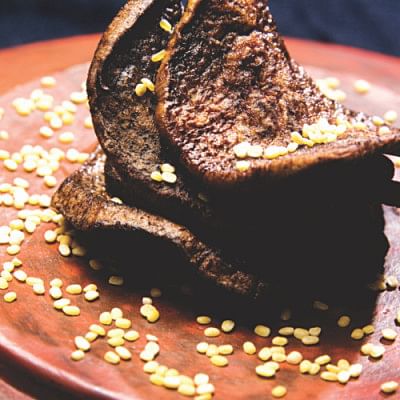
Method
Uniformly mix the elephant foot yam with the rest of the spice powder, lemon juice and salt in a bowl. Marinate the yam slices for 20-30 minutes. Shallow fry the slices in oil in a flat pan. Drain the yam chips on paper towels to remove excess oil. Garnish with coriander leaves and lemon wedges; serve hot.
MAAN KOCHUR MALAIKARI (TARO ROOT IN COCONUT MILK GRAVY)
The maan kochu or pani kochu (taro root), is a tropical root also known as colocasia or alocasia, the corn of which is edible. It is a seasonal vegetable, available widely during monsoon.
Maan kochur malaikari remains one of the most favourite dishes in the Bengali household. The high content of carbohydrates, proteins, minerals and vitamins make taro root with high nutritional value.
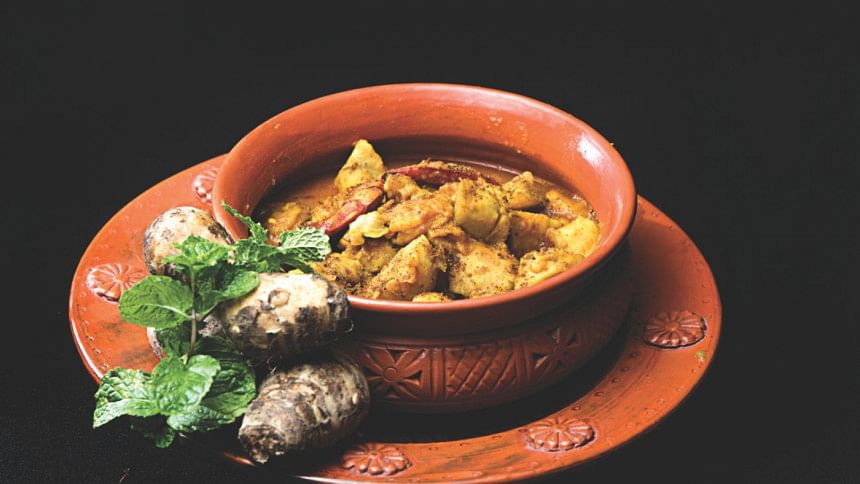
Ingredients
1 large maan kochu (taro root)
Salt per taste
10 gooseberries (amlokis)
1 tbsp tamarind pulp
2 tbsp ghee
1 tsp turmeric powder
2 tsp red chilli powder
2 tbsp ginger paste
1 tsp garam masala powder
2 cups coconut milk

Method
With a sharp knife cut out the rough outer rind of the maan kochu. Slice it into 4 pieces. Bring water to a boil in a big pan. Boil maan kochu, 4 tsp salt, amlokis and tamarind pulp until the kochu is slightly tender.
Strain the kochu and cut into 2½ cm-long pieces. Discard the water along with amlokis and tamarind pulp. Heat ghee in a wok; add the kochu pieces, and sauté. Add turmeric powder, red chilli powder, ginger paste and garam masala powder.
Sauté the mix, stirring for a minute. Pour coconut milk. Mix well and bring to a boil. Sprinkle salt. Mix well and simmer, stirring occasionally until kochu is spongy and ready to eat.
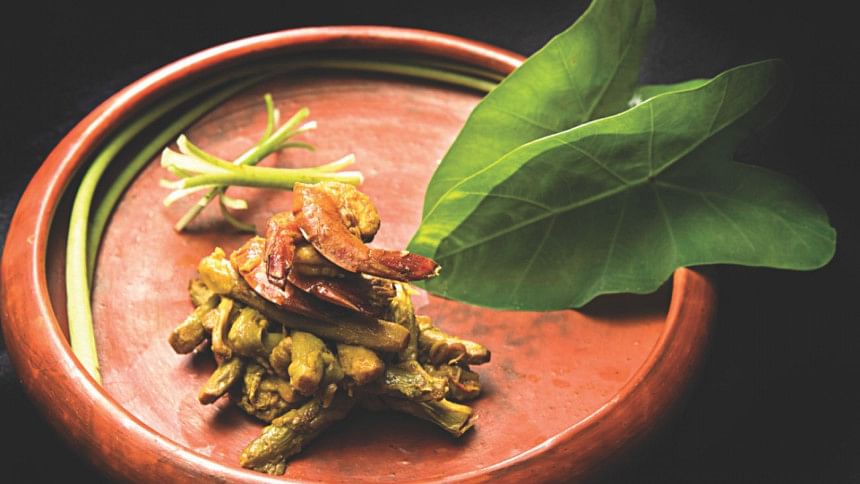
MUKHI KOCHUR DALNA (TARO ROOT CURRY)
In Bengali it is called mukhi or gathi kochur dalna. As a root vegetable, it tastes well with shrimp. This recipe, however, is strictly vegetarian. Some prefer to cook it with a mix of onions and ginger, though I prefer to not use them. The mukhi has its own flavour which should not be overshadowed by the use of other vegetables.
Taro root contains dietary fibre and carbohydrates. It is full of vitamin A, C, E, B6 and folate, as well as magnesium, iron, zinc, phosphorus and potassium.
Ingredients
10 pieces taro root (slice into halves)
1 medium potato (cut into cubes)
1 medium tomato, chopped
½ cup green peas, blanched in warm water
3 green chilli, silted
½ tsp cumin seeds (kalo jeera)
2 to 4 red chillis, powdered
2/3 cups mustard oil
Salt to taste
¼ tsp garam masala powder

Method
Heat oil in a pan, fry taro root and potatoes with little salt and turmeric powder one by one and keep aside. Add onion seeds in the rest of the oil; add green chilli and chopped tomato. Sauté for a while. Add salt and all the spices powder with little water to the pan. When the oil comes out, add 2 cups water and let simmer on the stove. Add fried taro root, potato cube and green peas and bring to a boil. Adjust salt and sprinkle garam masala powder and turn off the stove. Serve with plain rice.
Tip
Before cooking the taro root, marinate with lemon juice for 10 minutes to avoid the infamous itchy reaction.
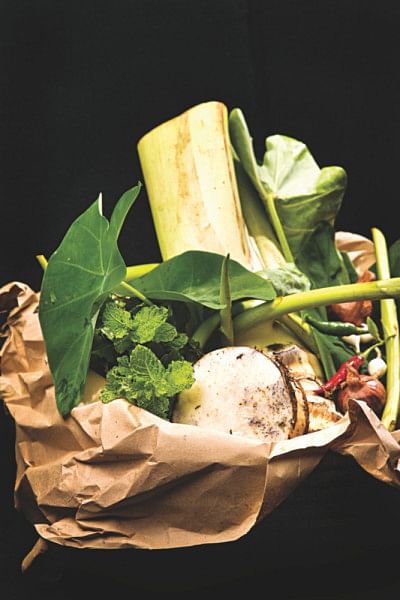
KOCHUR LOTI WITH CHINGRI (TARO STOLON WITH PRAWNS)
Kochur loti with chingri is yet another popular Bangladeshi delicacy. I have added some new flavour to it by adding shredded coconut. You can cook these taro stolons in different ways, but this one is my personal favourite.
Ingredients
500g taro stolon
½ cup small size prawns
1 medium size onion
4 to 5 tbsp mustard oil
2 pinch nigella seeds
5-6 green chilli, 1 tsp red chilli powder
Salt to taste
2 tbsp grated coconut
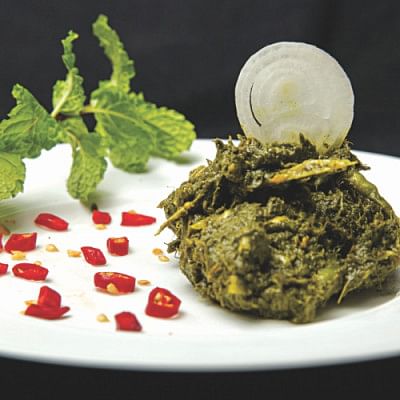
Method
Cut the loti into 2 inch pieces and boil them for five minutes in salted water. Drain water and keep aside. Clean, de-vein and wash prawns thoroughly under running water. Marinate them with some salt and turmeric powder and set aside. Heat oil in a pan and fry the prawns until light golden brown, then take them out and set aside. In the remaining oil, add nigella seeds and green chilli. Then add sliced onion and sauté for 2-3 minutes. Now add the boiled loti, red chilli powder, turmeric powder and salt. Mix them well and cook on medium heat for 10 minutes.
Do not add any water because the loti will release water. When the released water dries up and oil appears, add fried prawns and grated coconut, stir and cook for 3-5 minutes and take it off the stove. The dish is ready to serve.

KOCHU SHAK ER GHONTO (MASHED TARO LEAVES CURRY)
Ghonto is a semi thick preparation where veggies are mostly used in a mashed form and sometimes some portion of fish is also added, mostly the head.
Ingredients
2 bunches of edible taro/kochu stems
2 pieces hilsa fish-heads
½ cup onion, chopped
1 tsp garlic, chopped
2 tsp red chilli powder
1 tsp turmeric powder
4 pieces green chilli, ½ cup oil
Salt to taste
Method
Cut and wash the kochu. Boil the kochu with the salt and 2 cups of water until tender. Strain it in a colander and keep aside. Heat oil in a pan and put in the chopped onion and garlic, frying them until brown. Now add red chilli powder, turmeric powder and salt to it. Cook for few minutes. Put in the fish-heads. Mix well and cook for 5 minutes, with sprays of water to stave off any burning. When the water is fully evaporated, add boiled taro and green chilli and keep stirring. When the mixture looks well done, take it off the stove and serve hot with plain rice.
Tip
While chopping and washing the (kochu) stems, either use gloves or rub oil on your hands as a precaution, as kochu might cause slight irritation or itching.
Photo: Sazzad Ibne Sayed
Food styling: RBR

 For all latest news, follow The Daily Star's Google News channel.
For all latest news, follow The Daily Star's Google News channel. 



Comments